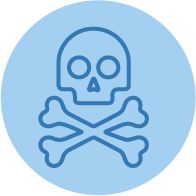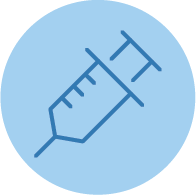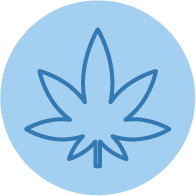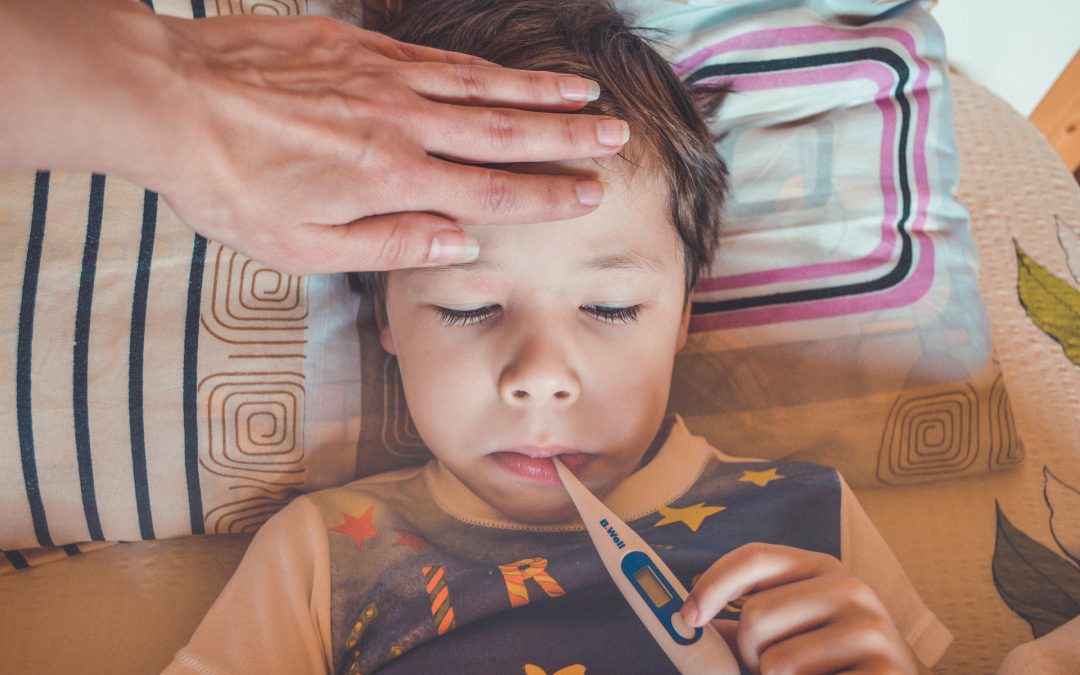POISONING
Preventable poisonings are a significant cause of both unintentional and intentional injuries, often resulting in hospitalization.

For Canadians aged 1-4 years, 15% of unintentional injury hospitalizations are poisonings.1
OVERVIEW
Poisoning is a significant factor in both unintentional and intentional injury-related deaths, as well as in injury hospitalizations, in B.C.2
In 2021/22, unintentional poisoning ranked as the second highest cause of injury hospitalizations for children aged 4 years and younger in BC. Additionally, it ranks as one of the top five causes of injury hospitalizations in the 5 to 84-year age group.3 In 2020, over a third of all cases reported to poison centres across Canada involved children aged 5 years and younger. 4
Any substance consumed in excess can result in poisoning. Substances that result in a poisoning, and the populations at risk of poisoning, vary greatly by intent and lethality. Alcohol, drugs, or medicinal agents are the predominant substances that result in over 90% of unintentional poisoning deaths and 85% of poisoning hospitalizations.
Poisoning in Young Children
Medication (including prescribed and over-the-counter) is the leading cause of poisoning in children. Other products that can be poisonous to children include:
- Alcohol
- Household cleaners (detergent pods, bleach)
- Personal hygiene products (mouthwash, nail polish)
- Garden products
- Car fluids (windshield fluid, oil)
- Cannabis products (oils, edibles)
Poisoning in Teenagers and Adults
Both unintentional and intentional poisonings are common injuries among Canadian teenagers and adults. Common substances involved include:
- Acetaminophen and ibuprofen
- Opioids and illicit drugs
- Alcohol
- Antidepressants
- Cannabis products
Poisoning in Older Adults
Unintentional poisoning among older adults typically involves:
- Prescribed or over-the-counter medications
- Consuming the wrong medication or incorrect dose
- Alcohol
Intentional poisoning may also occur, commonly involving:
- Pain medication
- Sedatives

Among Canadians aged 10-17 years, poisoning accounted for 88% of intentional self-harm hospitalizations in girls and 82% in boys.5
RESEARCH
Poisoning Study: The relationship between injury, opioid prescribing and overdose and overdose death
Using a large linked administrative dataset from PopDataBC, we are looking to understand the pathway and risk factors between an injury and an illicit drug overdose event. Specifically, this project aims to determine whether opioid prescription, opioid agonist therapy, whether the injury was work-related, and the profession affected the risk of overdose. Read more on the PopDataBC website.
BC Children’s Hospital CHIRPP Program Substance Use Project
The Substance Use Project aims to capture all intentional and unintentional pediatric poisonings observed in the emergency department at BC Children’s Hospital. Topics covered include alcohol and cannabis-related poisonings in 2016-2018; alcohol and illicit drug-related poisonings in 2019; and trends in pediatric poisonings during the COVID-19 pandemic. This project is funded by the Public Health Agency of Canada.

Fentanyl-related deaths in BC increased from 0.3 per 100,000 people in 2012 to 12.1 per 100,000 people in 2016 (a 40-times increase), resulting in the declaration of an ongoing public health emergency in April 2016.6
PREVENTION
Current evidence suggests the following best practices to prevent poisoning-related events or reduce their effects:
- Keep products in their original containers. Make sure they are clearly labeled.
- Install Canadian-certified carbon monoxide detectors in your home and have gas appliances serviced regularly.
- Have a Poison Control emergency number handy in case of emergency. BC DPIC: 1-800-567-8911 toll-free in B.C. or 604-682-5050 in Greater Vancouver.
- Do not try to make the person vomit if you suspect poisoning unless advised do to so by poison control or a medical professional.7
To Protect Young Children:
- Keep dangerous products out of sight and out of reach of children.
- Place safety latches on all drawers or cabinets containing harmful products, including medicine, alcohol and cannabis products, and cleaning products.
- Be mindful of where cannabis products are stored—especially edibles or cannabis-infused foods that imitate sweets, candies, or baked goods. Always ensure that any unconsumed cannabis is returned to its child-resistant packaging and not left on surfaces easily accessible to children.
- Use products that have child-resistant safety caps. Be aware that child-resistant caps are not child-proof.
- Avoid the use of cleaning products when children are close by.
- Do not take medicine in front of a child, and never call medicine “candy.”
- Keep all cigarettes, butts, and ashtrays away from children.
- Ensure that visitors to your home place their purses and bags out of reach of children.
- Identify poisonous household plants, label each plant with its exact name, and keep plants off the floor and out-of-reach from young children.

While typically not fatal, cannabis poisoning can require urgent medical attention, especially for children.8
RESOURCES
- Injury Insight: Cannabis Poisoning Among Children & Youth (PDF) (June 2020)
- Injury Insight: Alcohol Poisoning Among BC Youth (PDF) (January 2022)
News

New study examines the cost of poisonings in BC
In 2016, poisonings cost the province $812.5 million.

Cold and flu season is here—and it looks different
Cold and flu season is here. Learn what to do about the medication shortage.

Poison Prevention Week 2021
This year’s campaign focuses on the dangers of poisoning from cannabis consumption.
Study on cannabis poisoning in BC children published
Most poisonings occurred as a result of the co-ingestion of cannabis with other substances, like alcohol.

Restarting Activities & Preventing Injuries During COVID-19
We’re still all in this together.
Tide Pods are not candy, or a joke
The detergent chemicals inside these pods is highly concentrated and poisonous.
1. Yanchar, N.L., Warda, L.J., Fuselli, P., Canadian Paediatric Society, Injury Prevention Committee. (2012). Position Statement: Child and youth injury prevention: A public health approach. Available from: https://www.cps.ca/documents/position/child-and-youth-injury-prevention
2. BC Vital Statistics, Ministry of Health. Data accessed from Chronic Disease and Injury Data Mart, BCCDC (as of July 27th, 2023). 2017-2021
3. Discharge Abstract Database (DAD), Ministry of Health
4. Parachute. Poison Prevention Policy. Available from: https://parachute.ca/en/professional-resource/policy/poison-prevention/#:~:text=Medication%20is%20the%20leading%20cause,antifreeze
5. Canadian Institute for Health Information. (2014). Intentional Self-Harm Among Youth in Canada. Available from: https://www.cihi.ca/sites/default/files/info_child_harm_en.pdf
6. Baldwin, N. et al. (2018). Fentanyl and heroin contained in seized illicit drugs and overdose-related deaths in British Columbia, Canada: An observational analysis. Drug Alcohol Depend. 185, 322–327.
7. HealthLinkBC. (2018). Poisoning. Available from: https://www.healthlinkbc.ca/health-topics/poins#tw9579
8. Government of Canada. (2019). Cannabis in Canada: Get the facts. Available from: https://www.canada.ca/en/services/health/campaigns/cannabis.html
